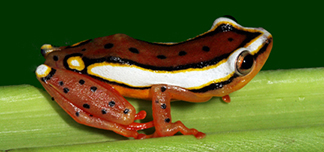Afrixalus dorsalis is a small to medium sized Afrixalus, which is found in three disjunctive areas in western Africa. Typically preferring grassland to forest, this anuran may be one of the few African vertebrates to be a beneficiary of the relentless deforestation occurring in most of the continent.
The IUCN lists this anuran as Least Concern in view of its wide distribution, tolerance of habitat modification, presumed large population, and because it is deemed by the IUCN as not likely to be declining sufficiently to qualify for listing in a more threatened category (Schiøtz et al., 2009). However, the Angolan population is more precarious, since some consider the Angolan occurrences as disjunctive from each other and from the larger northerly populations. Furthermore, the prolonged strife in Angola has exacerbated habitat protection (World Wildlife Fund & Hogan, 2007) and the ability to properly survey the Angolan anuran populations.
This anuran is found in the protected area of Kyabobo National Park (Leaché et al. 2006) within the Togo Hills of Ghana. The species is likely to occur in other protected areas, but no protected areas in Angola are thought to be applicable due to the protracted military actions and instability in that country starting in 1974.
As of 2009, the IUCN did not acknowledge threats to A. dorsalis (Schiøtz et al. 2009). However, the expanding human population in the region is an inherent threat to anurans. Moreover, WWF and Hogan have described the particular threats in Angola due to fragmented populations of A. dorsalis and the 39 year warfare that hinders Angolan conservation work (World Wildlife Fund & Hogan, 2007).
The IUCN suggests that populations of A. dorsalis are actually increasing due to the fact that this species may be a beneficiary of the widespread ongoing deforestation in its range (Schiøtz et al. 2009) In Angola, the situation may be more complex. World Wildlife and Hogan (2007) discuss the inherent risks to the species populations within the Angolan Miombo woodlands ecoregion due to the almost four decade long warfare in Angola. On the other hand, the same paper acknowledges the widespread slash-and-burn deforestation, a practice that diminishes forests in favour of grassland, and could be benefical to A. dorsalis.
A. dorsalis adult males are typically in the range of 25 to 28 millimetres (snout-vent length); adult females correspondingly achieve a snout-vent length of 26 to 29 millimetres (Schiøtz, 1999).
The herpetofauna of the region is only moderately species-rich; for example, there are two associate strict-endemic frog species in the Angolan Miombo woodlands ecoregion: the Angola Ornate Frog (Hildbrandtia ornatissima) and the Anchieta's Treefrog (Leptopelis anchietae), and one other near-endemic frog, the Luita River Reed Frog (Hyperolius vilhenai). Among the reptiles, there are strictly endemic species, including Bocage’s Horned Adder (Bitis heraldica). The upland areas of Angola such as the Bié Plateau, which form the heart of the Angolan Miombo ecoregion, do not appear to be notable centers of reptile or amphibian endemism. Most of the herpetofauna is shared with the broader miombo region (World Wildlife Fund & Hogan, 2007).
A. dorsalis is found in three major disjunctive populations: (1) from eastern Sierra Leone easterly to western Togo; (2) from western Nigeria into the western part of Democratic Republic of Congo; (3) and in western subcoastal Angola. However, it is possible that the Angolan population is in fact contiguous with the population to the north. Other observation records from Uganda and western Kenya actually refer to Afrixalus osorioi (Schiøtz et al., 2009).
This species is distributed in the following countries: Angola; Cameroon; The Democratic Republic of the Congo; Côte d'Ivoire; Equatorial Guinea; Gabon; Ghana; Guinea; Liberia; Nigeria; Sierra Leone (Schiøtz et al. 2009).
A. dorsalis is typically found in grassy vegetation, cultivated land, bush land and degraded forest in the forest belt and in forest outliers and gallery forests in moist savanna. It is rather adaptable as to habitat, but requires some type of sheltering cover. The species does not occur in primary rainforest (Schiøtz et al., 2009)
